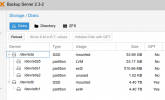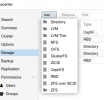Hi,
Is there a good practice where to put the data, so you don't get very large backups of the virtual machine? I'm thinking I should put the data outside the VM and then mount it into the VM. But I could be wrong here?
Any suggestions or recommendation of doing this another way?
Is there a good practice where to put the data, so you don't get very large backups of the virtual machine? I'm thinking I should put the data outside the VM and then mount it into the VM. But I could be wrong here?
- Create a volume for data
- Create a VM/LXC for running the fileserver (in this case Samba)
- Mount the volume -> VM
- Backup the VM as usual (vzdump)
- Run a backup schedule inside on VM to backup the data files on the mounted volume incrementally.
Any suggestions or recommendation of doing this another way?



